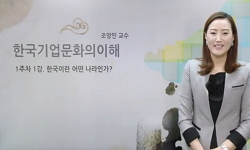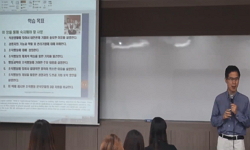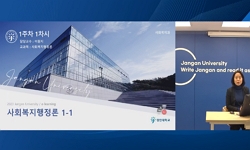본 연구는 조직 구성원이 현재 및 선호하는 조직문화 유형을 인식하는데 있어서 직급,직종.직군,리더십 스타일에 따라 차이가 있는지를 밝히고자 하였다.이 연구결과는 조직 내 조직문화 인...
http://chineseinput.net/에서 pinyin(병음)방식으로 중국어를 변환할 수 있습니다.
변환된 중국어를 복사하여 사용하시면 됩니다.
- 中文 을 입력하시려면 zhongwen을 입력하시고 space를누르시면됩니다.
- 北京 을 입력하시려면 beijing을 입력하시고 space를 누르시면 됩니다.
https://www.riss.kr/link?id=T11573082
- 저자
-
발행사항
서울 : 연세대학교 교육대학원, 2009
-
학위논문사항
학위논문(석사) -- 연세대학교 교육대학원 , 산업교육전공 , 2009. 2
-
발행연도
2009
-
작성언어
한국어
- 주제어
-
발행국(도시)
서울
-
기타서명
(A) study on the differences of perception of the organizational Culture depending on personal leadership styles
-
형태사항
vii, 71장 : 삽도 ; 26 cm
-
일반주기명
지도교수: 최항석
- 소장기관
-
0
상세조회 -
0
다운로드
부가정보
국문 초록 (Abstract)
본 연구는 조직 구성원이 현재 및 선호하는 조직문화 유형을 인식하는데 있어서 직급,직종.직군,리더십 스타일에 따라 차이가 있는지를 밝히고자 하였다.이 연구결과는 조직 내 조직문화 인식 차이로 발생할 수 있는 내부 갈등의 중요한 원인을 규명하는데 그 목적이 있으며,조직 내 문화적 차이로 인한 심리적 갈등과 조직 불신을 최소화하고,올바른 방향으로 조직 문화를 발전시켜 나가는데 중요한 기초 자료로 활용하고자 한다.이러한 연구목적을 달성하기 위해 조직문화에 관한 문헌고찰과 국내 대기업 1곳을 선정하여 설문조사를 실시한 후,신뢰도와 타당도가 검증된 연구도구를 사용하여,직급,직종.직군간 조직문화 인식차이를 검증하기 위해 교차분석을 실시하였고,리더십 스타일에 따른 조직문화 인식차이를 검증하기 위해 일원변량 분석을 실시하였다.연구결과,조직문화를 인식하는데 있어서 직급간,직종.직군간 차이가 있었으며,리더십 스타일에 있어서는 선호하는 조직문화 인식에 있어서 차이가 있음을 알 수 있었다.본 연구결과를 바탕으로 도출한 결론은 다음과 같다.첫째,직급에 따른 현재 및 선호하는 문화 유형 인식에 있어서 부서의 책임자인 ‘팀장’의 경우 다른 직급과 현저한 차이가 있었다.팀장의 경우,다른 직급에 비해서 현재 문화로 관계 및 혁신문화를 응답하는 비율이 높고,위계문화는 낮았다.이러한 결과는 팀장은 부서를 책임지고,문화를 만들어가는 조직 내 중간 관리자로서 최근 조직 내 많이 요구되는 가치인 관계,혁신지향성은 과대평가하고,위계지향성은 과소평가한 것으로 보인다.이러한 결과는 팀장과 팀원들의 인식의 차이를 나타내는 것으로서,팀장은 현재를 만족스러운 팀 분위기로 평가하지만,실제로 팀원들은 불만이 쌓일 수 있는 상황을 의미한다.향후에는 팀장들이 자신들의 팀 문화를 제대로 인식하고,팀원들의 욕구를 파악할 수 있도록 효과적인 리더십 프로그램 개발과 상호 간 인식의 폭을 좁힐 수 있는 다양한 기회를 만들 필요성이 있다.둘째,개인에게 부여된 과업의 특성인 직종 및 직군에 따라서 조직문화 인식에 차이가 있음을 증명하였다.직종 및 직군에 따른 현재 및 선호하는 조직문화 조사 결과,구매/물류,기획,영업/마케팅,사업장 관리 부문은 비교적 업무상 책임과 역할이 뚜렷하고,조직으로부터 부여된 목표와 성과가 명확하여,현재 및 선호 문화 유형에 있어서 차이가 적게 나타났다.반면 기술직,서비스,일반사무,자산시설관리 직군은 조직문화 인식 상당한 차이가 나타나 전문성보다는 다양한 역할을 병행해서 수행해야 하는 직무의 경우에는 조직 방향성에 혼란이 많은 것으로 이해된다.셋째,개인의 행동성향인 리더십 스타일에 따라 선호하는 조직 문화 유형이 다를 수 있음을 부분적으로 증명하였다.기존 연구에서는 개인의 인구통계학적 특성이나 최고 경영자나 관리자들의 리더십 스타일에 따른 현재 조직문화 유형의 차이에 관한 연구가 대부분이었지만,본 연구를 통해서 선호하는 조직문화 유형과 조직 구성원들의 행동성향과의 관련성을 새롭게 제시하게 되었다.연구결과,단일 조직 내 소수 응답비율을 나타낸 혁신,위계문화에서만동일한 가치를 추구하는 리더십스타일 유형과의 관련성이 높은 것으로 나타났다.이는 조직의 전체방향과 다르게 조직문화를 인식하고,선호하는 경우 개인의 성향,가치관이 더 반영되는 것으로 이해할 수 있다.이는 조직 내 반문화형성의 중요한 원인을 발견한 것으로 해결책의 중요한 실마리가 될 것이다.본 연구 결과를 통해서 개인의 특성에 따라서 다양한 조직문화가 존재한다는 것을 증명하였다.동일 조직(또는 부서)내의 구성원이라 해서 모두 같은 유형의 사람으로 취급해서는 안되며 개인의 조직 내 역할에 따라 현재 조직을다르게 인식하고,다른 방향의 변화를 기대할 수 있다는 것을 이해해야 한다.이러한 연구 결과 토대로 조직문화를 만들어 가는데 중추적 역할을 담당하는 조직 관리자나 HRD 담당자들은 조직구성원의 개인적 성향과 조직 내 역할 등을 고려하여 서로 간의 차이를 이해시키고 발전적 방향으로 논의가 될 수 있도록 조직과 조직구성원의 다리 역할을 담당해야 한다.
다국어 초록 (Multilingual Abstract)
The purpose of this study was to analyze the differences of organizational members' perception of their current and preferred organizational culture types depending on their ranks, job responsibilities & positions and leadership styles and thereby, de...
The purpose of this study was to analyze the differences of organizational members' perception of their current and preferred organizational culture types depending on their ranks, job responsibilities & positions and leadership styles and thereby, determine the major causes for development of theintra-organizational conflicts into perceived differences of the organizational culture, and thereupon, provide for some basic data useful to minimization of the psychological conflicts and distrust of the organization due to differences of perceived organizational culture and correct development of the organizational culture.For this purpose, the researcher reviewed the literature about the organizational culture and thereupon, sampled a large company in Korea for a questionnaire survey. A survey tool proven for its reliability andvalidity was used for the tabulation testing the differences of perceived organizational culture depending on ranks, responsibilities & positions as well as for one-way ANOVA testing the differences of perceivedorganizational culture depending on the leadership styles.As a result, there was found differences of perceived organizational culture depending on ranks and responsibilities & positions as well as on the leadership styles.This study can be concluded as follows;First, 'team leaders' had quite different perception of their current and preferred organizational culture types than other ranks. More of them than others perceived that their current organizational culture was relational and innovative, while it was less hierarchial. Such results seemed to be attributable to the fact that because team leaders were middle managers responsible for their teams, creating an organizational culture, they tended to overestimate the relational and innovative organizational culture required much recently, while underestimating the hierarchical organizational culture. Such resultsmay represent differences of perception between team leaders and members; team leaders tend to assess the current organizational culture as satisfactory, while team members may be dissatisfied withit. Hence, it is deemed necessary to develop an effective leadership program whereby team leaders can recognize their team culture correctly and understand their team members' needs, while providingfor diverse opportunities to narrow the gap of perception between team leaders and members.Second, it was found that perception of the organizational culture differed depending on responsibilities & positions given to individuals. As a result of analyzing the differences of the current and preferredorganizational cultures depending on responsibilities & positions, it was found that such departments as purchasing/logistics, planning, operation/marketing and business center management were relatively clearly defined for their business responsibilities and roles with their goals and achievements apparently specified. Thus, there was narrower difference of perception of the current and preferredorganizational culture among those staff and employees working for such departments. In contrast, there was found wider difference of perception among engineers, service people and administrativeofficials, which suggests that those staff and employees obliged to perform diverse roles rather than a single professional role may beconfused about directionality of their organization.Third, this study proved partially that the organizational culture types preferred might differ depending on individuals' behavioral tendencies or leadership styles. Preceding studies have focused mostly on differences of the organizational culture types depending on individuals' demographic variables or top management's or managers' leadership styles, but this study suggested the relationship betweenthe organizational culture types preferred and organizational members' behavioral tendencies. After all, this study found that the innovative or hierarchical organizational culture rarely perceived in the sampleorganization was highly related with the leadership styles pursuing the same values. Such finding may well be interpreted in such a way that many organizational members may recognize or prefer theirorganizational culture differently from their organizational direction, while their perceived or preferred organizational culture may reflect their personal traits or value systems. Such assumption may providefor an important clue to resolution of an anti-organizational culture.All in all, this study proved that diverse organizational cultures could be perceived depending on individuals' traits. So, it is not desirable to treat the members of the same organization (or department) uniformly; it is important to understand that they may perceive their organization differently, expecting it to change in different directions.Based on the results of this study, it is required of organization managers or HRD personnels playing a core role in creating an organizational culture to take into consideration their organizational members' personal traits and intra-organizational roles and thereby, help them understand the differences of the others' perception and discuss them in a positive way and thereby, play a role of bridge between their organization and its members.












